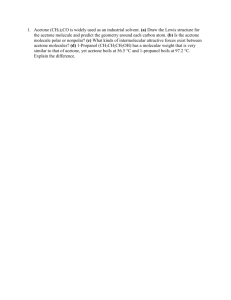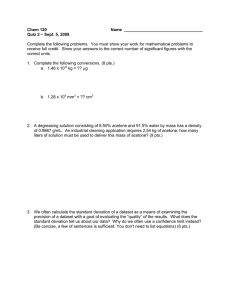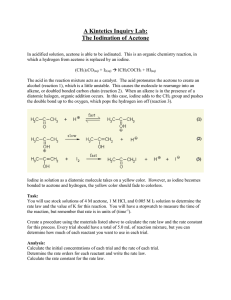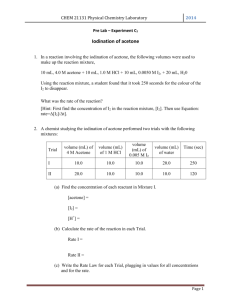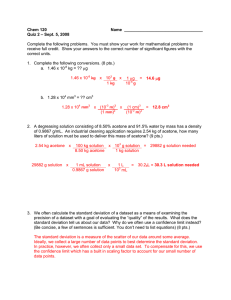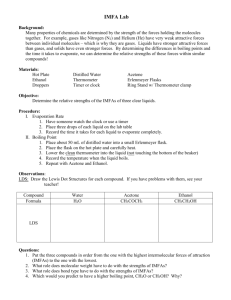Name:_____________ Chemistry 114 Second Hour Exam
advertisement
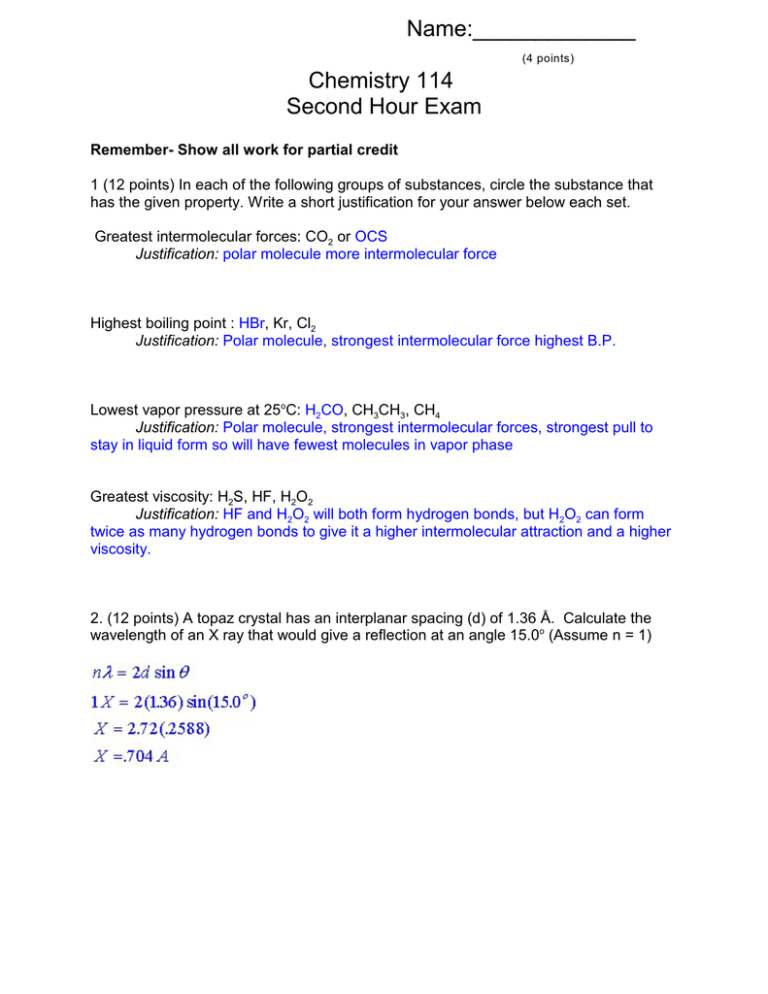
Name:_____________ (4 points) Chemistry 114 Second Hour Exam Remember- Show all work for partial credit 1 (12 points) In each of the following groups of substances, circle the substance that has the given property. Write a short justification for your answer below each set. Greatest intermolecular forces: CO2 or OCS Justification: polar molecule more intermolecular force Highest boiling point : HBr, Kr, Cl2 Justification: Polar molecule, strongest intermolecular force highest B.P. Lowest vapor pressure at 25oC: H2CO, CH3CH3, CH4 Justification: Polar molecule, strongest intermolecular forces, strongest pull to stay in liquid form so will have fewest molecules in vapor phase Greatest viscosity: H2S, HF, H2O2 Justification: HF and H2O2 will both form hydrogen bonds, but H2O2 can form twice as many hydrogen bonds to give it a higher intermolecular attraction and a higher viscosity. 2. (12 points) A topaz crystal has an interplanar spacing (d) of 1.36 Å. Calculate the wavelength of an X ray that would give a reflection at an angle 15.0o (Assume n = 1) 2 3. (12 points) What type of solids will each of the following substances form: CO2 Molecular Si Atomic network I2 Molecular KBr Ionic graphite Atomic Network Ar Atomic Group 8A 4. (12 points) The normal boiling point of acetone is 56.5 oC. What is the boiling point we would observe for this solvent when we have a pressure of .87 atm in the lab? (The ªHvap for acetone is 32.0 kJ/mol) 3 5 (12 points) I’m going to mix 10 grams of acetone (CH3COCH3) with 90 grams of water (H2O). The resulting solution has a volume of 96 mls. What is molarity of acetone in solution? Moles acetone = 10g x (1 mole/58.08g) = .1722 moles molarity = mole/liter solution = .1722 mol/.096 R = 1.79M What is molality of acetone in solution? Molality = mole/kg solvent = .1722 moles/.09 kg water = 1.92m What is mole fraction of acetone in this solution? Moles water = 90 g x (1 mole/18.016g) = 5.00 moles ÷acetone = .1722/(.1722+5.00) = .033 6A (6 points) I am going to mix acetone and chloroform together in a solution. At 35oC the vapor pressure of pure acetone is 345 torr, while that of chloroform is 293 torr. Make a rough graph of the vapor pressure of this solution (Y) as a function of mole fraction acetone (X), assuming the solution follows Raoult’s law. Make sure you include the points where mole fraction of acetone = 0 and 1 on your graph. (Note: you do NOT have to make any calculations!) When X = 0, then solution contains only chloroform and VP = 293 When X = 1, then solution contains only acetone and VP = 345 Plot these two points and connect them with a line 6B. (6 points) It is observed that when you mix acetone and chloroform the solution gets hotter. Would this correspond to a positive or negative deviation from Raoults’ law? Negative In the graph above (6A) use a dashed line to propose how you would adjust your line to show this deviation. 4 7. (12 points) Benzene has a boiling point of 80.1oC and a freezing point of 5.5 oC. It has a Kb of 2.53 oC@kg/mol and a Kf of 5.12 oC@kg/mol. After I dissolve a solute into pure benzene, the resulting solution has a boiling point of 85 oC. What is the freezing point of this solution? Calculate molality from boiling point depression, and then use that to calculate freezing point ÄT = KB m 85-80.1=2.53m 4.9/2.53=m; m = 1.937m ÄT = Kfm ÄT=5.12(1.937) ; ÄT = 9.92oC Tfreezing = 5.5-9.9 = -4.4oC 8 (12 points) I wish to determine the form of the integral rate law for the reaction : A + B 6C When I follow the rate of disappearance of A under different concentrations of A and B I observe the following rates [A] (M) [B] (M) Rate (mole/R@sec) .4 .4 1.20 .4 1.1 7.41 1.1 1.1 20.37 What are the order parameters for A and B and the k of this reaction?

